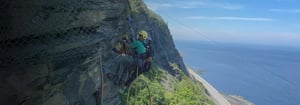The world is full of natural wonders, and mountains are among the most impressive. However, with their breathtaking beauty comes a dangerous reality: rockslides. These seemingly unpredictable events can cause serious damage to infrastructure and people. Understanding how they occur is essential for preventing them. That's why a joint initiative between Prof Francis Gauthier from the Laboratoire de géomorphologie et de gestion des risques en montagne (LGGRM) at the Université du Québec à Rimouski (UQAR) and Prof Giroux from the Institut national de la recherche scientifique (INRS) was launched. The initiative intends to monitor water flow behind the rockface in Gros-Morne, a small village in Gaspésie, QC. The goal of this project was to gain a better understanding of the waterflow mechanism behind the rockface and the corresponding impact on rockslides.
The challenge of this project was not only in understanding the complex waterflow mechanism but also in deploying the monitoring stations in extremely challenging locations. The monitoring stations had to be lightweight, compact, and able to operate with minimal power requirements. They also had to be easily installed and monitored, considering the high altitude location of the project. The solution was found in the Pegasus system.
The Pegasus proved to be a natural fit for this challenging deployment location, which could only be reached by rappelling down the cliff to the station 300 ft above the ground. The ultra lightweight and compact Pegasus digitizer was a perfect fit for this situation. The ability to pre-configure station profiles and then quickly apply them via the mobile app also minimized the time literally spent hanging out at the deployment site.
To monitor seismic activity, the Pegasus digitizer was combined with geophones, batteries, and solar power for year-round monitoring. The versatility of the Pegasus system made it possible to set the gain and use a high sample rate while providing insights into complete station health information, such as power consumption.
To harvest the data, Nanometrics provided a portable harvesting pod as it was the perfect complement to the low SWaP (Size, Weight, and Power) requirements of the stations. The addition of the Data Vault allowed the INRS team to minimize the amount of equipment they carried while rappelling down the side of the cliff. Instead of bringing along a laptop to harvest the data, they could simply slip the ultra-low SWaP Data Vault into a pocket.
The success of this project demonstrates the importance of collaboration and innovation in solving complex problems. The deployment of the Pegasus ecosystem, along with other innovative technologies, is helping researchers gain a better understanding of the waterflow mechanism behind the rockface and the corresponding impact on rockslides. This understanding will assist in developing effective strategies to prevent and mitigate their effects, such as designing more resilient infrastructure and implementing early warning systems to alert people in the event of a potential rockslide. It can also inform land use planning and zoning regulations to prevent construction in high-risk areas. Ultimately, this understanding can save lives and protect communities from the devastating effects of rockslides. The project is a testament to the power of science and technology to make the world a safer place.


